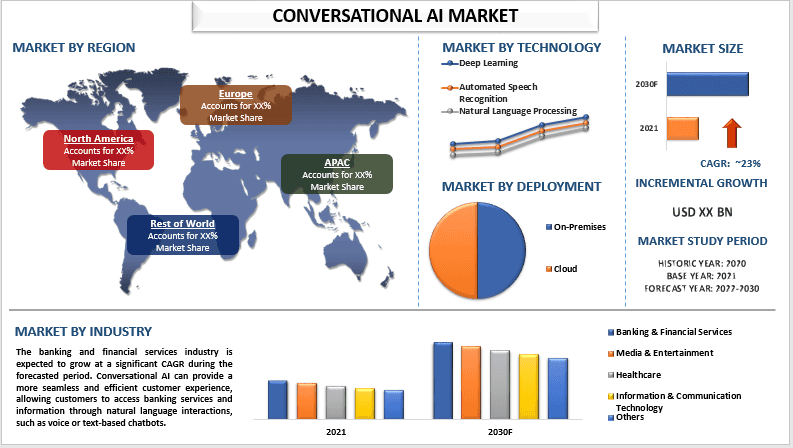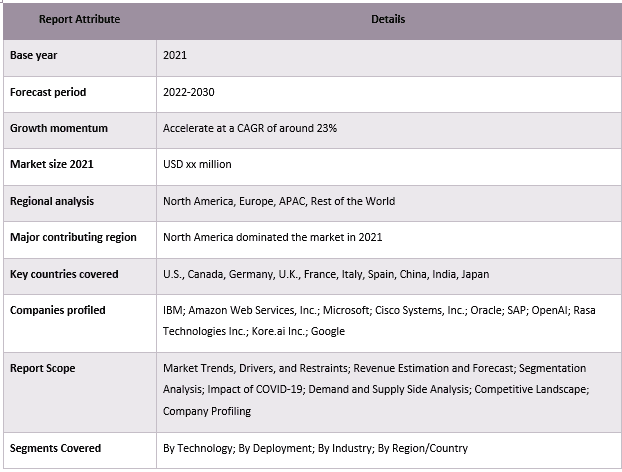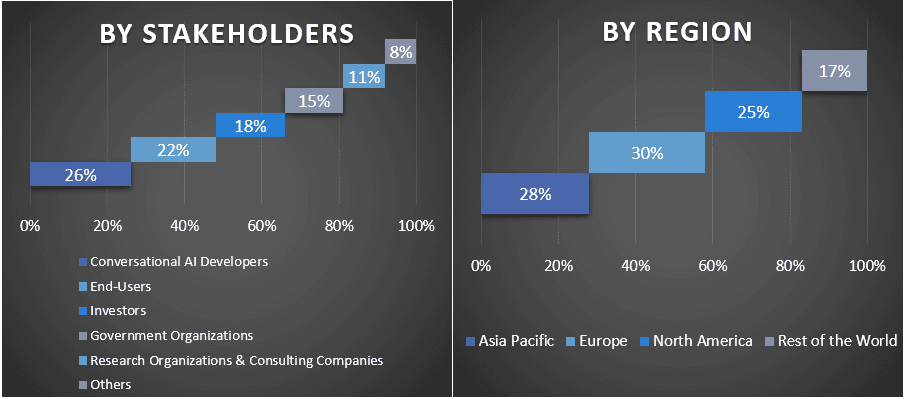- Startseite
- Über uns
- Industrie
- Dienstleistungen
- Lesen
- Kontaktieren Sie uns
Markt für Konversations-KI: Aktuelle Analyse und Prognose (2022-2030)
Schwerpunkt auf Technologie (Deep Learning, automatisierte Spracherkennung und Verarbeitung natürlicher Sprache); Bereitstellung (On-Premises und Cloud); Branche (Banken & Finanzdienstleistungen, Medien & Unterhaltung, Gesundheitswesen, Informations- & Kommunikationstechnologie und Sonstige); und Region/Land

Der Markt für Konversations-KI hatte eine Marktgröße von rund 7 Milliarden USD und wird voraussichtlich mit einer stabilen Rate von rund 23 % wachsen, was auf die wachsende Nachfrage nach KI-basierten Kundensupport-Diensten zurückzuführen ist.Konversations-KI ist eine Technologie, die natürliche Sprachinteraktionen zwischen Mensch und Maschine ermöglicht, wie z. B. Chatbots oder Sprachassistenten. Konversations-KI hat sich in der Geschäftswelt zunehmend etabliert, da sie zahlreiche Vorteile bietet, wie z. B. eine verbesserte Kundenerfahrung, erhöhte Effizienz und Kosteneinsparungen. Sie kann für eine Vielzahl von Anwendungen eingesetzt werden, darunter Kundensupport, Vertrieb, Marketing und Betrieb. Konversations-KI kann in verschiedenen Formen eingesetzt werden, z. B. Chatbots auf Websites oder mobilen Apps, Sprachassistenten in intelligenten Lautsprechern oder Smartphones und virtuelle Assistenten in Kundenservice-Centern oder Callcentern. Darüber hinaus sind die zunehmende Popularität von KI-basierten Chatbots und der Anstieg des Einsatzes von Omnichannel-Methoden weitere Faktoren, die dem Markt zum Wachstum verhelfen. Darüber hinaus sind die zunehmende Anzahl von Produkten, die auf dem Markt für Konversations-KI eingeführt werden, und die steigenden Investitionen in KI einige der wichtigsten Faktoren, die zum Wachstum des Marktes beitragen.So gab Google beispielsweise im Mai 2023 neue Ankündigungen für sein KI-generatives Tool Google Bard auf der Google I/O 2023-Veranstaltung bekannt. Das Tool wird jetzt in über 180 Ländern und Regionen verfügbar sein.
Zu den wichtigsten Akteuren auf dem Markt gehören IBM; Amazon Web Services, Inc.; Microsoft; Cisco Systems, Inc.; Oracle; SAP; OpenAI; Rasa Technologies Inc.; Kore.ai Inc.; Google. Mehrere M&A-Transaktionen zusammen mit Partnerschaften wurden von diesen Akteuren durchgeführt, um Kunden mit High-Tech- und innovativen Produkten/Technologien zu versorgen.
Im Bericht präsentierte Erkenntnisse
„Unter den Technologien hatte das Segment der Verarbeitung natürlicher Sprache im Jahr 2021 einen bedeutenden Marktanteil“
Basierend auf der Technologie ist der Markt in Deep Learning, automatisierte Spracherkennung und Verarbeitung natürlicher Sprache unterteilt. Das Segment der Verarbeitung natürlicher Sprache hatte im Jahr 2021 einen herausragenden Marktanteil und wird voraussichtlich während des Prognosezeitraums mit einer bemerkenswerten CAGR wachsen. Dies ist auf den technologischen Fortschritt, die wachsende Nachfrage nach anspruchsvolleren KI-Systemen und die Verfügbarkeit großer Datenmengen zur Schulung dieser Systeme zurückzuführen.
„Unter den Bereitstellungen hatte das On-Premises-Segment im Jahr 2021 einen herausragenden Marktanteil“
Auf der Grundlage der Bereitstellung wird der Markt in On-Premises und Cloud unterteilt. Davon dominierte die On-Premises-Bereitstellung im Jahr 2021 den Markt, hauptsächlich aufgrund der dem Kunden gebotenen Flexibilität, wodurch die Transaktion nur einmal durchgeführt wird. Darüber hinaus bietet die On-Premises-Bereitstellung Unternehmen mehr Kontrolle und Eigentum über ihre Daten und Infrastruktur. Dies ist besonders wichtig für Unternehmen, die mit sensiblen oder vertraulichen Informationen, wie z. B. Finanz- oder Gesundheitsdaten, umgehen und ein hohes Maß an Sicherheit und Compliance aufrechterhalten müssen.
„Nordamerika dominierte den Markt im Jahr 2021“
Nordamerika hielt im Jahr 2021 den größten Anteil am globalen Markt für Konversations-KI. Die technologisch fortschrittliche Geschäftslandschaft, die vielfältige Bevölkerung, die hohe Akzeptanzrate digitaler Technologien, die komplexe Gesundheitsbranche und der Fokus auf Innovation und Unternehmertum sind einige der wichtigsten Faktoren, die das Wachstum dieses Marktes in der Region antreiben. Darüber hinaus weist Nordamerika eine hohe Akzeptanzrate digitaler Technologien auf, wobei ein großer Prozentsatz der Bevölkerung Smartphones, soziale Medien und andere digitale Plattformen nutzt. Konversations-KI kann Unternehmen helfen, über diese Plattformen mit ihren Kunden in Kontakt zu treten und so eine nahtlosere und bequemere Erfahrung zu bieten.
Marktbericht für Konversations-KI: Abdeckung

Gründe für den Kauf dieses Berichts:
- Die Studie beinhaltet eine Marktabschätzung und -prognose, die von authentifizierten Branchenexperten validiert wurde.
- Der Bericht bietet einen schnellen Überblick über die Gesamtleistung der Branche auf einen Blick.
- Der Bericht enthält eine detaillierte Analyse prominenter Branchenakteure mit einem primären Fokus auf wichtige Finanzdaten, Produktportfolios, Expansionsstrategien und aktuelle Entwicklungen.
- Detaillierte Untersuchung der in der Branche vorherrschenden Treiber, Einschränkungen, wichtigsten Trends und Chancen.
- Die Studie deckt den Markt umfassend über verschiedene Segmente ab.
- Detaillierte Analyse der Branche auf regionaler Ebene.
Anpassungsoptionen:
Der globale Markt für Konversations-KI kann weiter an die Anforderungen oder ein anderes Marktsegment angepasst werden. Darüber hinaus versteht UMI, dass Sie möglicherweise Ihre eigenen Geschäftsanforderungen haben. Nehmen Sie daher Kontakt mit uns auf, um einen Bericht zu erhalten, der Ihren Anforderungen vollständig entspricht.
Inhaltsverzeichnis
Forschungsmethodik für die Marktanalyse von Konversations-KI (2022-2030)
Die Analyse des historischen Marktes, die Schätzung des aktuellen Marktes und die Prognose des zukünftigen Marktes des globalen Marktes für Konversations-KI waren die drei wichtigsten Schritte, die unternommen wurden, um die Einführung von Konversations-KIs in den wichtigsten Regionen weltweit zu erstellen und zu analysieren. Es wurde eine umfassende Sekundärforschung durchgeführt, um die historischen Marktzahlen zu sammeln und die aktuelle Marktgröße zu schätzen. Zweitens wurden zur Validierung dieser Erkenntnisse zahlreiche Ergebnisse und Annahmen berücksichtigt. Darüber hinaus wurden umfassende Primärinterviews mit Branchenexperten in der gesamten Wertschöpfungskette des globalen Marktes für Konversations-KI durchgeführt. Nach der Annahme und Validierung der Marktzahlen durch Primärinterviews wandten wir einen Top-down/Bottom-up-Ansatz an, um die vollständige Marktgröße zu prognostizieren. Danach wurden Methoden der Marktaufschlüsselung und Datentriangulation angewendet, um die Marktgröße von Segmenten und Untersegmenten der Branche zu schätzen und zu analysieren. Die detaillierte Methodik wird im Folgenden erläutert:
Analyse der historischen Marktgröße
Schritt 1: Detaillierte Untersuchung von Sekundärquellen:
Eine detaillierte Sekundärstudie wurde durchgeführt, um die historische Marktgröße des Marktes für Konversations-KI durch unternehmensinterne Quellen wieJahresberichte & Finanzberichte, Leistungspräsentationen, Pressemitteilungen usw.und externe Quellen einschließlichZeitschriften, Nachrichten & Artikel, Veröffentlichungen der Regierung, Veröffentlichungen der Wettbewerber, Sektorberichte, Datenbanken von Drittanbietern und andere glaubwürdige Veröffentlichungen.
Schritt 2: Marktsegmentierung:
Nachdem wir die historische Marktgröße des Marktes für Konversations-KI ermittelt hatten, führten wir eine detaillierte Sekundäranalyse durch, um historische Markteinblicke und -anteile für verschiedene Segmente und Untersegmente für die wichtigsten Regionen zu sammeln. Die wichtigsten Segmente sind im Bericht als Technologie, Bereitstellung und Industrie enthalten. Darüber hinaus wurden Länderanalysen durchgeführt, um die allgemeine Akzeptanz von Testmodellen in dieser Region zu bewerten.
Schritt 3: Faktorenanalyse:
Nach der Erfassung der historischen Marktgröße verschiedener Segmente und Untersegmente führten wir eine detaillierteFaktorenanalysedurch, um die aktuelle Marktgröße des Marktes für Konversations-KI zu schätzen. Darüber hinaus führten wir eine Faktorenanalyse unter Verwendung abhängiger und unabhängiger Variablen wie Technologie, Bereitstellung und Industrie des Marktes für Konversations-KI durch. Eine gründliche Analyse wurde für Angebots- und Nachfrageszenarien durchgeführt, wobei die wichtigsten Partnerschaften, Fusionen und Übernahmen, Geschäftserweiterungen und Produkteinführungen im Bereich des Marktes für Konversations-KI weltweit berücksichtigt wurden.
Schätzung und Prognose der aktuellen Marktgröße
Aktuelle Marktgrößenbestimmung:Basierend auf den umsetzbaren Erkenntnissen aus den obigen 3 Schritten kamen wir zu der aktuellen Marktgröße, den wichtigsten Akteuren auf dem globalen Markt für Konversations-KI und den Marktanteilen der Segmente. Alle erforderlichen prozentualen Anteile und Marktaufschlüsselungen wurden unter Verwendung des oben genannten sekundären Ansatzes ermittelt und durch Primärinterviews verifiziert.
Schätzung & Prognose:Für die Marktabschätzung und -prognose wurden verschiedenen Faktoren, darunter Treiber und Trends, Einschränkungen und Chancen für die Stakeholder, Gewichtungen zugewiesen. Nach der Analyse dieser Faktoren wurden relevante Prognosetechniken, d. h. der Top-down/Bottom-up-Ansatz, angewendet, um die Marktprognose für 2030 für verschiedene Segmente und Untersegmente in den wichtigsten Märkten weltweit zu ermitteln. Die Forschungsmethodik zur Schätzung der Marktgröße umfasst:
- Die Marktgröße der Branche, gemessen am Umsatz (USD), und die Akzeptanzrate des Marktes für Konversations-KI in den wichtigsten Märkten im Inland
- Alle prozentualen Anteile, Aufteilungen und Aufschlüsselungen von Marktsegmenten und Untersegmenten
- Schlüsselakteure auf dem globalen Markt für Conversational AI in Bezug auf die angebotenen Produkte. Außerdem die Wachstumsstrategien, die diese Akteure anwenden, um auf dem schnell wachsenden Markt zu bestehen
Marktgrößen- und -anteil-Validierung
Primärforschung:Tiefgehende Interviews wurden mit den Key Opinion Leaders (KOLs) durchgeführt, darunter Führungskräfte (CXO/VPs, Vertriebsleiter, Marketingleiter, Betriebsleiter, Regionalleiter, Länderleiter usw.) in wichtigen Regionen. Die Ergebnisse der Primärforschung wurden dann zusammengefasst und eine statistische Analyse durchgeführt, um die aufgestellte Hypothese zu beweisen. Die Ergebnisse der Primärforschung wurden mit den Sekundärbefunden konsolidiert, wodurch Informationen in umsetzbare Erkenntnisse umgewandelt wurden.
Aufschlüsselung der primären Teilnehmer in verschiedenen Regionen

Markt-Engineering
Die Daten-Triangulationstechnik wurde eingesetzt, um die gesamte Marktschätzung abzuschließen und präzise statistische Zahlen für jedes Segment und Untersegment des globalen Marktes für Conversational AI zu erhalten. Die Daten wurden nach der Untersuchung verschiedener Parameter und Trends in den Bereichen Technologie, Bereitstellung und Industrie auf dem globalen Markt für Conversational AI in mehrere Segmente und Untersegmente aufgeteilt.
Das Hauptziel der Globalen Conversational AI Marktstudie
Die aktuellen und zukünftigen Markttrends des globalen Marktes für Conversational AI wurden in der Studie ermittelt. Investoren können strategische Erkenntnisse gewinnen, um ihre Investitionsentscheidungen auf der Grundlage der in der Studie durchgeführten qualitativen und quantitativen Analysen zu treffen. Aktuelle und zukünftige Markttrends bestimmten die allgemeine Attraktivität des Marktes auf regionaler Ebene und boten den industriellen Teilnehmern eine Plattform, um den unerschlossenen Markt zu nutzen und von einem First-Mover-Vorteil zu profitieren. Weitere quantitative Ziele der Studien umfassen:
- Analyse der aktuellen und prognostizierten Marktgröße des Marktes für Conversational AI in Bezug auf den Wert (USD). Analysieren Sie auch die aktuelle und prognostizierte Marktgröße verschiedener Segmente und Untersegmente
- Zu den Segmenten der Studie gehören Bereiche der Technologie, Bereitstellung und Industrie
- Definition und Analyse des regulatorischen Rahmens für die Conversational AI-Industrie
- Analyse der Wertschöpfungskette mit der Präsenz verschiedener Intermediäre sowie Analyse des Kunden- und Wettbewerbsverhaltens der Branche
- Analyse der aktuellen und prognostizierten Marktgröße des Marktes für Conversational AI für die wichtigsten Regionen
- Zu den wichtigsten Ländern der in dem Bericht untersuchten Regionen gehören der asiatisch-pazifische Raum, Europa, Nordamerika und der Rest der Welt
- Unternehmensprofile des Marktes für Conversational AI und die Wachstumsstrategien der Marktteilnehmer, um auf dem schnell wachsenden Markt zu bestehen
- Detaillierte Analyse der Branche auf regionaler Ebene
Verwandt Berichte
Kunden, die diesen Artikel gekauft haben, kauften auch










